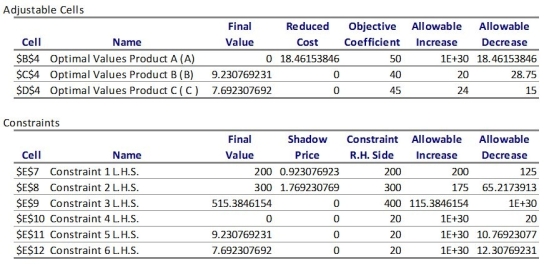A company can decide how many additional labor hours to acquire for a given week.Subcontractors will only work a maximum of 20 hours a week.The company must produce at least 200 units of product A,300 units of product B,and 400 units of product C.In 1 hour of work,worker 1 can produce 15 units of product A,10 units of product B,and 30 units of product C.Worker 2 can produce 5 units of product B,20 units of product B,and 35 units of product C.Worker 3 can produce 20 units of product A,15 units of product B,and 25 units of product C.Worker 1 demands a salary of $50/hr,worker 2 demands a salary of $40/hr,and worker 3 demands a salary of $45/hr.The company must choose how many hours they should hire from each worker to meet their production requirements and minimize labor cost.The sensitivity report is displayed below.

Answer the following questions:
a.How much of products A,B,and C should be produced?
b.Which constraints are binding? Which constraints are non-binding?
c.If constraint 2 is relaxed by one unit,how will the objective value be affected?
Correct Answer:
Verified
View Answer
Unlock this answer now
Get Access to more Verified Answers free of charge
Q34: A binding constraint means that the constraint
Q35: Use this information to answer the
Q36: The slack of a constraint indicates the
Q37: Use this information to answer the
Q38: Use this information to answer the
Q39: Surplus is typically associated with "≤" constraints.
Q40: The Reduced Cost may be viewed as
Q41: Use the information below to answer the
Q42: Use the information below to answer the
Q44: Use the information below to answer the
Unlock this Answer For Free Now!
View this answer and more for free by performing one of the following actions

Scan the QR code to install the App and get 2 free unlocks

Unlock quizzes for free by uploading documents